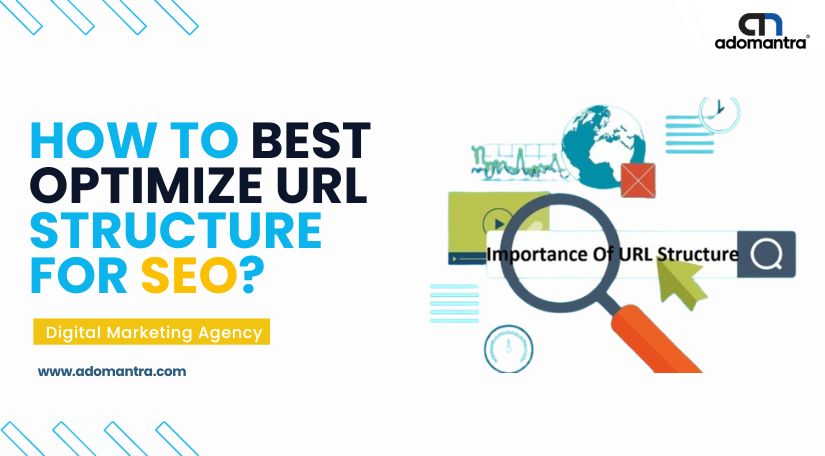
The Ultimate Guide for an SEO-Friendly URL Structure
In the ever-evolving landscape of digital marketing, Search Engine Optimization (SEO) remains a cornerstone of online success. It's a realm where every detail counts, and one often overlooked aspect with a profound impact is URL structure. The way you structure your URLs can significantly influence your website's visibility and ranking on search engines. Optimizing your URL structure is not just about aesthetics; it's about creating a roadmap for both users and search engine crawlers. In this comprehensive guide, we'll delve into the art and science of optimizing URLs for SEO, focusing on the key phrase, "Best Optimize URL Structure for SEO."
We'll explore the fundamental components of a URL, dissect why URL structure matters in the grand scheme of SEO, and provide you with actionable best practices to ensure your URLs are SEO-friendly. By the end of this journey, you'll have a deep understanding of how to craft URLs that not only appease search engines but also enhance user experience, ultimately driving more organic traffic to your website. So, let's embark on this URL optimization adventure and unlock the potential of your online presence.
What is URL Structure In SEO?
URL structure for SEO refers to the way a website's URLs are organized and formatted to enhance search engine optimization (SEO) performance. It involves designing URLs that are both user-friendly and easily understandable by search engines. A well-optimized URL structure can have a positive impact on your website's rankings in search engine results pages (SERPs) and overall user experience. Here are some key aspects of URL structure for SEO:
- Relevance: URLs should reflect the content of the page they lead to. Including relevant keywords in the URL can help search engines understand the page's topic and improve its chances of ranking for those keywords.
- Readability: URLs should be easy for both users and search engines to read and understand. Avoid using complex strings of numbers or special characters.
- Hyphens vs. Underscores: Hyphens (-) are recommended for separating words in URLs because they are more easily interpreted by search engines than underscores (_).
- Short and Descriptive: Keep URLs concise while conveying the page's content. Long, convoluted URLs can be confusing for users and less effective for SEO.
- Static vs. Dynamic: Static URLs are preferred over dynamic ones as they are more user-friendly and tend to rank better in search results.
- Canonicalization: Ensure that you have a consistent URL format (e.g., www vs. non-www, HTTP vs. HTTPS) to avoid duplicate content issues. Canonical tags can help with this.
- Folder Structure: Use a logical folder structure to organize content. For example, use "/blog/" for blog posts and "/products/" for product pages.
- Avoiding Duplicate Content: Implement proper redirects (e.g., 301 redirects) to resolve duplicate content issues caused by variations in URL structure.
- Avoiding Special Characters: Special characters, like "&" or "%", should be avoided in URLs as they can cause parsing issues for search engines.
- User Experience: A user-friendly URL structure contributes to a better overall user experience, which can lead to higher user engagement and conversions.
URL structure for SEO is about creating URLs that are relevant, readable, and user-friendly while adhering to best practices that make it easier for search engines to crawl and rank your website's pages. A well-optimized URL structure is an essential part of any successful SEO strategy.
Why Do URLs Matter For Search Engine Optimization?
URLs matter for Search Engine Optimization (SEO) for several important reasons:
- Visibility and Crawlability: Search engine crawlers use URLs to discover and index web pages. Clear and structured URLs make it easier for search engines to crawl and understand your website's content. When your URLs are easily accessible, your web pages have a better chance of being included in search engine results.
- User Experience: URLs are visible to users in search results and browser address bars. A well-structured and descriptive URL can provide users with a preview of the page's content, which can influence their decision to click on the link. User-friendly URLs can enhance the overall user experience and encourage higher click-through rates.
- Keyword Relevance: Including relevant keywords in your URLs can signal to search engines what your page is about. When users search for those keywords, search engines are more likely to display pages with matching keywords in the URL. This can improve your page's ranking for specific search queries.
- Shareability: Clear, concise, and user-friendly URLs are more shareable. When users share links on social media or other websites, an easily understandable URL is more likely to attract clicks and engagement. This can indirectly contribute to improved SEO through increased traffic and backlinks.
- Canonicalization: URL consistency is crucial to avoid duplicate content issues. Search engines may see URLs with variations (e.g., www vs. non-www, HTTP vs. HTTPS) as separate pages, potentially causing duplicate content problems. Proper canonicalization ensures that search engines index the correct version of your content.
- Link Structure: URLs are often used as anchor text in hyperlinks, both within your website and from external sources. Descriptive URLs provide context to users and search engines, helping them understand the content of the linked page.
- Ranking Signals: While not the most significant ranking factor, the structure and keywords in URLs are among the many signals that search engines use to determine a page's relevance and quality. When combined with other on-page and off-page SEO factors, well-optimized URLs can contribute to better rankings.
URLs matter for SEO because they play a crucial role in how search engines discover, index, and rank your web pages. By optimizing your URL structure for clarity, relevance, and user-friendliness, you can improve your website's chances of ranking higher in search results and attract more organic traffic.
Digital marketing encompasses all online advertising and promotional efforts that use electronic devices and the internet to connect with current and prospective customers. It's a broad field that includes various online channels and strategies aimed at reaching, engaging, and converting a target audience.
List Of 10 Best Optimize URL Structure for SEO
1. Words Used in URLs
Words used in URLs should be carefully selected to improve search engine optimization (SEO) and user experience. Best Optimize URL Structure for SEO Here are some important considerations when choosing words for URLs:
- Relevance: The words in the URL should accurately reflect the content and topic of the web page. Relevant keywords help search engines understand the page's content and improve its chances of ranking for those keywords.
- Keywords: Including relevant keywords in the URL can signal to search engines what the page is about. This can improve the page's visibility in search engine results when users search for those keywords.
- Conciseness: Keep URLs concise and to the point. Long and overly complex URLs can be confusing for users and may not display well in search results or when shared on social media.
- Hyphens: Use hyphens (-) to separate words in URLs. Hyphens are more readable and SEO-friendly than underscores (_) or spaces. For example, use "example.com/my-page" instead of "example.com/my_page" or "example.com/my page."
- Avoid Special Characters: Avoid using special characters like "&," "%," or "@" in URLs, as they can lead to parsing issues and are not as user-friendly.
- Lowercase Letters: Use lowercase letters in URLs. URLs are case-insensitive, but using lowercase consistently is a best practice for uniformity.
- Remove Stop Words: Stop words (e.g., "and," "the," "of") can be omitted from URLs to make them shorter and more focused on keywords. However, use your discretion, as some stop words may still be necessary for clarity.
- Use Descriptive Words: Choose descriptive words that give users and search engines a clear idea of the page's content. Avoid generic or vague terms.
- Avoid Dates: If possible, avoid including dates in URLs unless it's essential for your content (e.g., news articles, event pages). Dates can make URLs appear less evergreen and may not age well.
- Keep It Simple: Simplicity is key. URLs should be easy to remember, type, and share. Avoid unnecessary complexity or excessive subdirectories.
- Consistency: Maintain a consistent URL structure throughout your website. This helps with user navigation and SEO.
- Canonicalization: Ensure that you have a preferred version of your URLs (e.g., www vs. non-www, HTTP vs. HTTPS) to avoid duplicate content issues. Implement canonical tags if needed.
- 301 Redirects: If you change URLs or remove pages, implement 301 redirects to ensure that users and search engines are directed to the correct pages. This prevents broken links and retains SEO value.
The words used in URLs should be chosen thoughtfully to align with the content, improve SEO, and enhance user experience. A well-structured and descriptive URL can contribute to better search engine rankings and make it easier for users to navigate your website.
2. Hide The “www” Prefix
Hiding the "www" prefix in a website's URL is a common practice and can be done for various reasons, including aesthetics, simplicity, and branding. To hide the "www" prefix, you need to configure your web server and domain settings. Here's how you can do it:
-
Check Your Domain Registrar: First, check with your domain registrar (the company where you purchased your domain name) to see if they offer an option to configure this. Many domain registrars provide a simple option in their control panels to set your preferred domain.
-
Configure DNS Settings:
- Log in to your domain registrar's control panel.
- Look for DNS settings or DNS management.
- Create a DNS record (usually a CNAME record) pointing to your domain (e.g., example.com) instead of the "www" subdomain. This record will redirect requests to your domain without "www."
-
Update Website Hosting:
- Log in to your web hosting control panel.
- Access your website's settings or configurations.
- Ensure that your website is set to respond to requests for both "www" and non-"www" versions of your domain.
-
Set Up Redirects:
- To ensure that visitors are always directed to the non-"www" version of your site, set up 301 redirects. This is important for SEO and consistency.
- You can configure these redirects in your web server's configuration file or through your content management system (CMS). If you're using WordPress, for example, you can use a plugin like "Redirection" to manage redirects easily.
-
Test: After making these changes, thoroughly test your website to ensure that it properly redirects visitors from "www" to the non-"www" version of your domain.
-
Update Links: Review your website's internal links and update them to use the non-"www" version. Additionally, check any external links and notify partners or websites that link to you about the change to maintain consistency.
-
Monitor: Continuously monitor your website to ensure that the "www" prefix is consistently hidden and that there are no unexpected issues.
Keep in mind that while it's common to hide the "www" prefix, some websites still choose to use it for branding or other reasons. Ultimately, the decision depends on your preferences and how you want your website's URL to appear to visitors.
3. Use Hyphens to Separate Words
Using hyphens to separate words in URLs is a recommended practice for creating SEO-friendly and user-friendly URLs. Here's why using hyphens is beneficial:
- Readability: Hyphens make URLs more readable and user-friendly. They provide a clear visual separation between words, making it easier for both users and search engines to understand the URL's structure.
- Search Engine Optimization (SEO): Search engines consider hyphens as word separators. When you use hyphens to separate keywords in your URL, it helps search engines recognize and index the individual words. This can improve your page's visibility in search results for relevant queries.
- Keyword Recognition: If you include keywords in your URL, hyphens make it easier for search engines to identify and interpret those keywords. This can enhance your page's relevance for specific search queries.
- Avoiding Ambiguity: Hyphens help prevent ambiguity in URLs. Without hyphens, words in a URL can run together and become challenging to decipher. This clarity benefits both users and search engine crawlers.
- Consistency: Hyphens are the most widely accepted and recommended word separator for URLs. Using them consistently throughout your website ensures a standardized and predictable URL structure.
- URL Sharing: When users share URLs, especially in contexts like social media or email, hyphens improve the URL's readability and reduce the likelihood of errors when copying and pasting.
Example:
- Non-Hyphenated URL:
www.example.com/myproductpage - Hyphenated URL:
www.example.com/my-product-page
In the example above, the hyphenated URL is more readable and user-friendly, making it easier for both humans and search engines to understand the content of the page.
using hyphens to separate words in URLs is a best practice for creating SEO-friendly, user-friendly, and easily interpretable URLs. It contributes to better search engine rankings, improved user experience, and overall website usability.
4. Use of Sub-domains
Sub-domains are subdivisions of a domain name and are used to organize and categorize content within a website. Best Optimize URL Structure for SEO They can have various purposes and are a valuable tool for structuring and managing a website. Here are some common uses of sub-domains:
- Content Segmentation: Sub-domains can be used to organize different types of content or services within a website. For example, a news website might use sub-domains like "news.example.com" for news articles, "sports.example.com" for sports-related content, and "entertainment.example.com" for entertainment news.
- Localization: Sub-domains are often used for localization and internationalization. Each country or region can have its sub-domain with content tailored to that specific audience. For instance, "us.example.com" for the United States, "uk.example.com" for the United Kingdom, and so on.
- Mobile Version: Some websites use a sub-domain like "m.example.com" for their mobile-friendly version. This allows for a separate design and user experience optimized for mobile devices.
- Blogs: Many websites host their blogs on a sub-domain like "blog.example.com" to separate the blog content from the main website's content. This can also make it easier to manage and customize the blogging platform.
- E-commerce: In e-commerce, sub-domains can be used to categorize products or services. For instance, "store.example.com" for the main store, and "products.example.com" or "electronics.example.com" for specific product categories.
- User Accounts: Some websites create sub-domains for user-generated content or profiles. For example, a social networking site might use sub-domains like "user1.example.com" or "profile.example.com" for individual user pages.
- Testing and Development: Sub-domains can be handy for testing and development purposes. Developers can use a sub-domain like "dev.example.com" or "test.example.com" to work on new features or changes without affecting the live website.
- Marketing Campaigns: Sub-domains can be used for specific marketing campaigns or promotions. For instance, "summer-sale.example.com" can be set up for a seasonal sales campaign.
- APIs and Services: Sub-domains can also be used to host APIs (e.g., "api.example.com") or other web services that complement the main website's functionality.
- Branding: In some cases, companies use sub-domains to reinforce their branding. For example, a company might use "blog.brandname.com" to emphasize the brand within the URL.
When using sub-domains, it's essential to consider the impact on SEO, user experience, and website management. Properly configured sub-domains can help improve website organization, user navigation, and SEO optimization, while haphazard use may lead to confusion and negatively affect search engine rankings.
5. Avoid Using Special Characters and Capital Letters
Avoiding special characters and capital letters in URLs is considered a best practice for creating user-friendly, SEO-friendly, and consistent URLs. Here's why it's recommended:
- Consistency: URLs are case-insensitive, meaning that "example.com/Page" and "example.com/page" would be considered the same by most web servers and browsers. However, using consistent lowercase letters in URLs helps maintain uniformity and avoids confusion.
- Readability: Special characters and uppercase letters can make URLs less readable, especially for users who need to type or remember them. They may cause confusion or errors when entered manually.
- Search Engines: Search engines generally prefer lowercase characters in URLs. While search engines can interpret uppercase characters and special characters, using lowercase letters makes URLs more accessible and easier for search engine crawlers to process.
- Link Sharing: When users share URLs on social media or via email, special characters can sometimes lead to encoding issues or broken links. Using lowercase letters and avoiding special characters ensures that URLs are shareable without problems.
- Consistency in Links: Consistency in URL formatting helps with link building and backlinking efforts. Other websites are more likely to link to your content when URLs are simple, lowercase, and easy to remember.
- Avoiding % Encoding: Special characters in URLs often require percent-encoding (e.g., replacing spaces with " "). While this encoding is standard and acceptable, it can make URLs appear complex and less user-friendly.
To create URLs that avoid special characters and capital letters:
- Use hyphens to separate words (e.g., "my-page" instead of "my_page").
- Use lowercase letters exclusively (e.g., "example.com/page" instead of "example.com/Page").
- Avoid spaces, underscores, or other special characters in URLs (e.g., "product-review" instead of "product_review" or "product review").
By following these practices, you can create URLs that are consistent, user-friendly, and conducive to better SEO performance. Remember that while these guidelines are generally recommended, specific situations or requirements may warrant exceptions, so always consider the needs of your website and users.
6.The Role of Canonical Tags
Canonical tags, often referred to as rel="canonical" tags or canonical URLs, play a crucial role in Search Engine Optimization (SEO) by addressing the issue of duplicate content. Here's an explanation of the role of canonical tags in SEO:
- Handling Duplicate Content: Duplicate content occurs when the same or very similar content exists at different URLs within a website or across different websites. Search engines may struggle to determine which version of the content to index and rank, potentially leading to lower search engine rankings or dilution of SEO efforts.
- Specifying the Preferred URL: The primary purpose of canonical tags is to specify the preferred or canonical URL for a piece of content. By including a canonical tag in the HTML of a page, website owners or webmasters tell search engines which version of the content should be considered the authoritative or main one.
- Preventing SEO Issues: Canonical tags help prevent SEO issues that can arise from duplicate content. They guide search engines to focus on indexing and ranking the preferred URL while consolidating the ranking signals (such as backlinks and user engagement) associated with duplicate versions.
- Maintaining User Experience: Canonical tags also contribute to a better user experience. When users click on search results or shared links, they are directed to the preferred URL, ensuring that they consistently access the intended content.
- Content Syndication: In cases where content is syndicated or republished on multiple websites, canonical tags can be used to point back to the original source URL. This helps avoid duplicate content penalties and gives credit to the original content creator.
- Dynamic Content: Websites with dynamic URLs that generate multiple versions of a page (e.g., sorting, filtering, or pagination) can use canonical tags to consolidate ranking signals and focus on the main page.
- E-commerce and Product Variations: In e-commerce, where similar product pages may exist with minor variations (e.g., different colors or sizes), canonical tags can be used to indicate the primary product page.
To implement a canonical tag:
- Add the tag in the section of the HTML document for the pages where you want to specify the canonical URL.
- Replace "preferred-url" with the actual URL of the preferred or canonical version of the page.
It's important to note that canonical tags are a directive, not a directive. While search engines typically follow canonical tags, they may not always comply if they believe there's a better reason not to. Therefore, canonical tags should be used judiciously and in conjunction with other SEO best practices to ensure optimal SEO performance and improved user experience.
7. URL Parameters and Tracking
URL parameters are strings of text and values that are added to the end of a URL to pass information to a web page. They are commonly used for tracking and managing various aspects of website interactions, such as user behavior, marketing campaigns, and dynamic content. Here's a deeper look at URL parameters and their role in tracking:
- Tracking User Behavior: URL parameters can be used to track user interactions and behaviors on a website. For example, parameters can capture data such as source, medium, campaign, and keywords to help businesses understand how users find and navigate their site.
- Campaign Tracking: When running online advertising campaigns, marketers often use URL parameters to track the performance of specific ads or promotions. This data helps evaluate the effectiveness of various marketing channels and campaigns.
- Analytics Integration: Many analytics tools, such as Google Analytics, support URL parameters for tracking. Marketers can append tracking parameters to URLs, and the analytics platform collects and reports data on user actions associated with those parameters.
- Dynamic Content: URL parameters can be used to deliver dynamic content based on user input or preferences. For example, an e-commerce site might use parameters to filter products by category or sort items by price.
- A/B Testing: URL parameters are essential for A/B testing and split testing. Different versions of a webpage (A and B) can be served using parameters, and the results are tracked to determine which version performs better.
- Session Tracking: Parameters can be employed to track user sessions or to pass session-related data between pages. This helps maintain user context and state during navigation.
- User Authentication and Authorization: Parameters can be used to pass authentication tokens or authorization information when users log in or access secure areas of a website.
- Pagination and Sorting: In websites with paginated content or sortable tables, parameters can be used to specify the page number or sorting criteria. This allows users to navigate through large datasets.
- Filtering and Search Queries: E-commerce websites often use URL parameters to filter search results based on user-selected criteria (e.g., price range, brand, color).
- URL Shorteners: URL shortening services, like Bitly or TinyURL, use parameters to redirect users to the original long URL while capturing click data for analytics.
- Cleaning and Handling Parameters: To ensure that parameters do not negatively impact SEO, websites often employ best practices such as parameter handling settings in search engine tools, specifying which parameters to index or exclude from indexing.
When using URL parameters for tracking, it's important to consider the following:
- Maintain a consistent naming convention for parameters to ensure clarity and uniformity.
- Be cautious with sensitive information, as parameters are visible in the URL and can potentially be manipulated.
- Implement proper handling of parameters to prevent duplicate content issues in SEO.
- Regularly review and analyze tracking data to make informed decisions and optimize website performance.
Overall, URL parameters are a versatile tool for tracking and enhancing user experiences on websites, provided they are used judiciously and with a clear understanding of their implications.
8. Add your mobile URLs to a sitemap
Creating a separate sitemap for mobile URLs is a good practice, especially if you have a mobile-responsive website or a dedicated mobile version. Best Optimize URL Structure for SEO A mobile sitemap helps search engines understand the structure and content of your mobile pages, improving mobile search visibility. Here are steps to add your mobile URLs to a sitemap:
- Identify Mobile URLs: Determine which URLs are specific to your mobile version. These might include URLs with "m." or "/mobile/" in the subdomain or directory.
- Create a Mobile Sitemap: You can create a separate XML sitemap specifically for your mobile URLs. Use a sitemap generator tool or create it manually.
Include Mobile URLs in the Sitemap:
- Add the mobile-specific URLs to your mobile sitemap. Each URL should have its and tags.
http://www.example.com/mobile-page1
http://www.example.com/mobile-page2
Specify Mobile Sitemap in Robots.txt:
In your website's robots.txt file, specify the location of the mobile sitemap by adding a reference to it. For example:
Sitemap: http://www.example.com/mobile-sitemap.xml
- Submit Mobile Sitemap to Search Engines: Go to Google Search Console (or other search engine webmaster tools) and submit your mobile sitemap. This informs search engines about the existence of your mobile-specific content.
- Monitor and Maintain: Regularly monitor the performance of your mobile URLs in search results. Update the mobile sitemap whenever you add or remove mobile-specific pages.
9. Include your target keyword
Including your target keyword in the URL is an essential aspect of optimizing URL structure for SEO. Here are some tips on how to effectively include your target keyword:
- Incorporate the Keyword Naturally: Your target keyword should be included in the URL in a way that feels natural and relevant to the content of the page. Avoid keyword stuffing, which can harm your SEO efforts.
- Use the Keyword in the Slug: The "slug" is the part of the URL that comes after the domain name and directory structure. It's where you should aim to include your target keyword. For example, if your keyword is "best running shoes," a good URL structure might be "example.com/best-running-shoes."
- Keep It Concise: While it's important to include the keyword, keep the URL concise and focused. Avoid adding unnecessary words or stop words (e.g., "and," "the," "of") that can make the URL longer without adding value.
- Use Hyphens to Separate Words: Use hyphens (-) to separate words in the URL. Hyphens are more SEO-friendly than underscores or spaces and are recommended by search engines.
- Match URL to Page Content: Ensure that the keyword you include in the URL accurately reflects the content of the page. The URL should provide a clear indication of what users can expect to find on the page.
- Avoid Repetition: If your target keyword naturally appears more than once in the content, you don't need to repeat it excessively in the URL. A single instance in the slug is usually sufficient.
- Consider Long-Tail Keywords: If your target keyword is highly competitive, consider incorporating long-tail variations of the keyword into the URL. Long-tail keywords can be more specific and relevant to the user's search intent.
- Optimize for User Experience: While SEO is important, don't sacrifice user experience for the sake of including keywords in the URL. The URL should be user-friendly and easy to read.
- Update URLs When Necessary: If you decide to target a different keyword or if the focus of a page changes, be prepared to update the URL accordingly. Implement proper redirects (e.g., 301 redirects) when changing URLs.
Remember that optimizing the URL structure is just one aspect of SEO. It's essential to create high-quality, valuable content that matches the user's intent and provides a positive user experience. Additionally, consider other on-page and off-page SEO factors to improve your website's overall search engine rankings.
10. Common Mistakes to Avoid
Avoiding common mistakes is crucial when optimizing URL structure for SEO. Here are some common URL structure mistakes to avoid:
- Using Lengthy and Complex URLs: Long, convoluted URLs can confuse both users and search engines. Keep URLs concise and focused on the main topic or keyword.
- Using Special Characters: Special characters like "&," "%," or "@" can cause parsing issues in URLs and are best avoided.
- Overusing Keywords: While it's essential to include relevant keywords in URLs, overstuffing them with keywords can appear spammy. Use keywords naturally and prioritize readability.
- Including Dates in URLs: Unless you have a specific need for dates in URLs (e.g., news websites), avoid including them as they can make content appear outdated.
- Ignoring URL Hierarchy: Failing to organize URLs into a logical hierarchy can lead to a disorganized website structure. Use folders and subfolders to structure content logically.
- Using Dynamic URLs: Dynamic URLs with parameters (e.g., "?id=123") can be less SEO-friendly than static, descriptive URLs. Whenever possible, use static URLs for important pages.
- Changing URLs Without Redirects: When changing a URL, implement 301 redirects to the new URL to avoid broken links and loss of SEO value.
- Inconsistent URL Formats: Maintain consistency in URL formats (e.g., www vs. non-www, HTTP vs. HTTPS) to prevent duplicate content issues.
- Ignoring Canonicalization: Failing to implement canonical tags when necessary can lead to duplicate content problems. Use canonical tags to specify the preferred version of a page.
- Not Monitoring Broken Links: Broken links can harm user experience and SEO. Regularly check for broken links and fix them promptly.
- Not Considering Mobile Users: Ensure that your URL structure is mobile-friendly and that mobile users can easily navigate your site.
- Neglecting User Experience: URLs should not only be optimized for search engines but also for users. A user-friendly URL structure enhances navigation and trust.
- Ignoring Analytics Data: Regularly review analytics data to assess the performance of your URLs. Identify which URLs are driving traffic and which may need optimization.
- Using Undescriptive URLs: URLs that lack context or descriptive keywords make it challenging for users and search engines to understand the content.
- Forgetting to Update URLs in Internal Links: When you change a URL, make sure to update internal links to reflect the new URL structure.
By avoiding these common URL structure mistakes, you can create a more SEO-friendly and user-friendly website that is better positioned to rank well in search engine results and provide an excellent experience for your visitors.
Conclusion
In the dynamic world of digital marketing, where every click and every visitor count, optimizing your website for search engines is paramount. Your URL structure, often overlooked but immensely influential, can make or break your SEO efforts. As we've journeyed through the intricacies of URL optimization, it's abundantly clear that crafting a user-friendly and search engine-pleasing URL structure is far from an arbitrary task. From the significance of relevance and readability to the power of hyphens and the nuances of canonicalization, each aspect plays a vital role in enhancing your website's online presence. Best Optimize URL Structure for SEO By adhering to best practices and avoiding common pitfalls, you pave the way for higher search engine rankings, increased organic traffic, and improved user experiences. In this digital landscape, where every detail matters, optimizing your URL structure is not merely a choice; it's a necessity. So, armed with the knowledge acquired here, embark on your SEO journey, and unlock the full potential of your online presence through a meticulously optimized URL structure.







